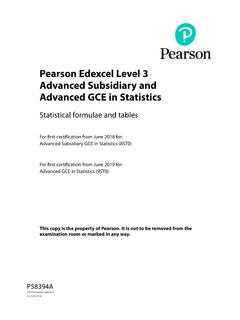Transcription of A guide to Grade A* and percentage uniform marks
1 University of Cambridge International Examinations (CIE) is making some changes to the way Cambridge IGCSE, O Level and International A/AS Level results are reported from June 2010. A guide to Grade A* and percentage uniform marksAdditional results reporting for Cambridge learners from June 2010 The changes will give more detailed reporting about individual performance, and will support the progression of Cambridge learners as they move through education to university and beyond. Frequently asked questionsWill Grade A* be published for Cambridge International AS Level?No. The UK Government is not introducing Grade A* for UK AS Level, and Grade A* is not being introduced for Cambridge International AS Level will a candidate s Cambridge International A Level final result be calculated if they took the Cambridge International AS Level in June or November 2009 before Grade A* was introduced?
2 It makes no difference to the final Cambridge International A Level Grade if a candidate has sat Cambridge International AS Level components prior to June 2010. Candidates Cambridge International A Level results in the June 2010 session will be calculated in exactly the same way, regardless of when they sat the Cambridge International AS Level components. How will Grade A* be reported on CIE results documents?Cambridge certificates, statements of results, and syllabus results by component will show A*(a*) at syllabus level. Broadsheets will display an asterisk (*) where the A* Grade is awarded. CIE Direct and the Candidate Results website will show the A* Grade in online documents.
3 Do Centres need to include Grade A* on the Forecast Grade Form?Yes. Centres will need to predict Grade A* on the Forecast Grade Form in the usual offering Cambridge IGCSE will already be familiar with Grade A*, the highest level of achievement. From the June 2010 exam session, Grade A* will be introduced for Cambridge O Level and International A Level worldwide. Grade A* will widen the Grade scale for Cambridge O Level and International A Level and will recognise achievement at the top of Grade A. The publication of Grade A* does not mark a change in Cambridge standards; the standards of Grades A to E will stay exactly the same as they are now.
4 CIE is introducing Grade A* for Cambridge International A Level from June 2010 to coincide with the introduction of Grade A* for UK A Level. UK universities requested Grade A* to help distinguish between the best candidates, and so we believe it is important that Cambridge students have access to the same Grade range as their UK peers. Cambridge International A Level is recognised and accepted around the world as equivalent on a Grade -for- Grade basis to UK A Level. Benefits of Grade A* for Cambridge learners Provides additional recognition of achievement Gives access to the same Grade range as their UK peers Ensures university admissions tutors give due recognition to Cambridge International A Level applicants alongside UK A Level applicantsGrade A* for Cambridge O Level and International A LevelPercentage uniform marksThe information below is intended as a guide for schools in countries where percentage uniform marks will appear on statements of results for Cambridge IGCSE, O Level and International A/AS Level from June uniform marks correspond to the grades available (A*, A.)
5 B, C etc) and will give students additional information about their performance. They will show students whether they are in the middle of a Grade , or near either the top or the bottom. For example, a student who obtains the minimum mark necessary for a Grade A* obtains a percentage uniform mark of 90. A student who obtains a mark halfway between Grade D and Grade C will achieve a percentage uniform mark of table below shows the minimum percentage uniform mark for each Grade :Are percentage uniform marks the same as the uniform Mark Scale (UMS) used by UK exam boards?CIE s percentage uniform mark scale uses the same approach as UMS.
6 However the UMS is not always shown as marks out of 100, whereas CIE percentage uniform marks are always out of percentage uniform marks appear on Cambridge certificates?No. They will be published on the statement of results to supplement the Grade issued at syllabus a student achieves 100 percentage uniform marks , did they achieve full marks ?Not necessarily. It is possible for a student to achieve 100 percentage uniform marks without achieving full marks on the question asked questionsThe percentage uniform mark will be stated at syllabus level only. The percentage uniform mark is not the same as the actual mark that the candidate obtains on the question paper, since it depends on the position of the Grade thresholds (which may vary from one session to another and from one subject to another) and it has been converted into a percentage .
7 The percentage uniform mark will always be calculated out of 100. Grade thresholdPercentage uniform markA*90A80B70C60D50E40F (Cambridge IGCSE only)30G (Cambridge IGCSE only)20 Sample statement of resultsThe illustration below shows how Grade A* and percentage uniform marks will be reported on the statement of results from June 2010, where example shows a Cambridge International A Level student who has achieved Grade A*. percentage uniform marks will appear on statements of results only, not on of ResultsAICE HALF CREDIT, GCE advanced subsidiary AND GCE advanced LEVELC andidate NameDate of Birth Centre / Cand. SPECIMEN XX/XX/XXXX XXXXX/XXXXC entre NameSession To be quoted on allCAMBRIDGE INTERNATIONAL SAMPLE CENTRE June 2010 correspondence GCE AS & A Level
8 percentage UniformSyllabus Syllabus Title Qualification Result Mark9231 Further Mathematics advanced Level A*(a*) 939709 Mathematics advanced Level A*(a*) 92 Explanatory Notes This statement of results is not a certificate.
9 CIE reserves the right to amend the information given on this statement, which will be confirmed by the issue of certificates. The text advanced Level or advanced subsidiary prefixing the Grade awarded indicates the level that the Grade was awarded for the syllabus. advanced Level results are reported in a 6-point scale of grades: A*(a*), A(a), B(b), C(c), D(d) or E(e), Grade A*(a*) being the highest and Grade E(e) the lowest. advanced subsidiary Level results are reported on a 5-point scale of grades: a(a), b(b), c(c), d(d) or e(e), Grade a(a) being the highest and Grade e(e) the lowest. The content and difficulty of advanced subsidiary Level examinations is equivalent to the first half of a corresponding advanced Level course.
10 Under some circumstances where a candidate is entered for advanced Level but does not achieve a Grade E(e) or above, CIE will award an advanced subsidiary Level Grade a(a) to e(e) in the subject. AICE Half-Credit results are reported on a 5-point scale of grades: A(a), B(b), C(c), D(d) or E(e), Grade A(a) being the highest and Grade E(e) the lowest. UNGRADED indicates that the candidate has failed to reach the standard required for either a pass at advanced Level or advanced subsidiary Level or AICE Half-Credit. NO RESULT indicates that a result cannot be issued because of absence for the whole or part of the examination in the syllabus or because of a decision not to issue a result for some other reason.

